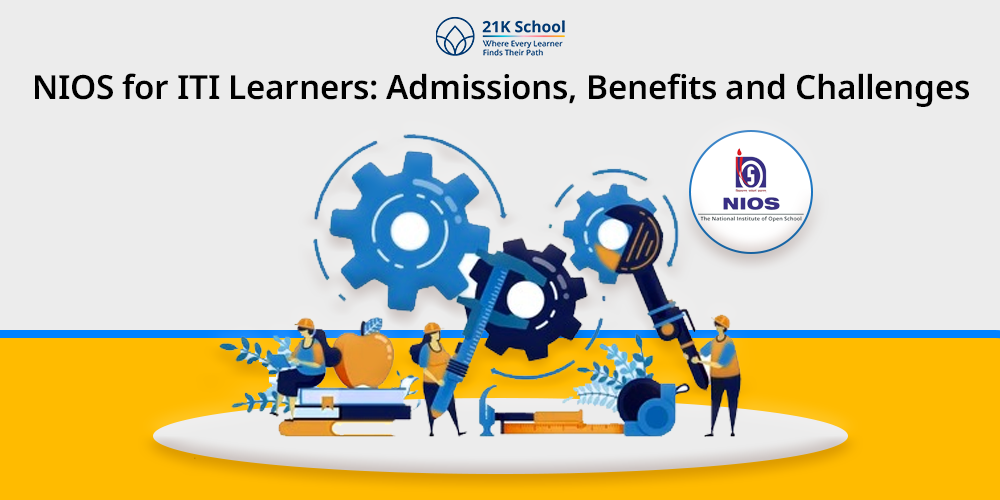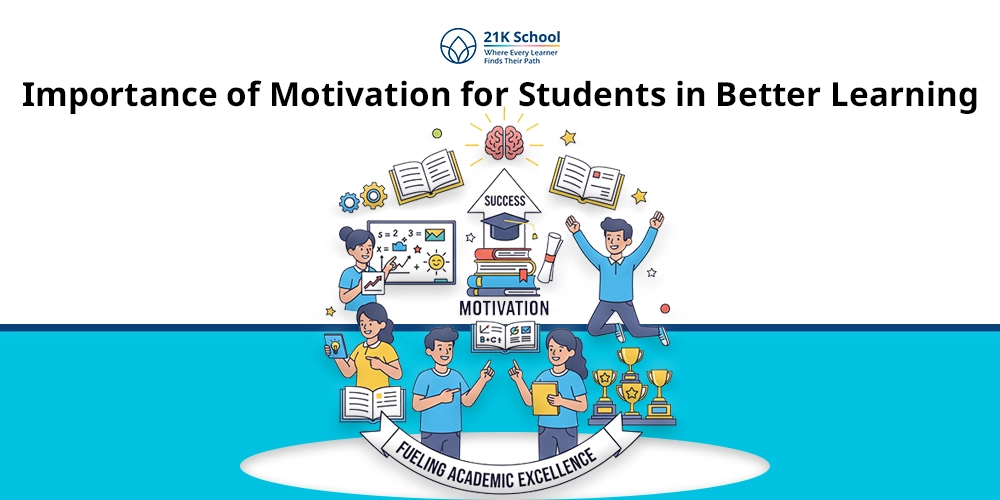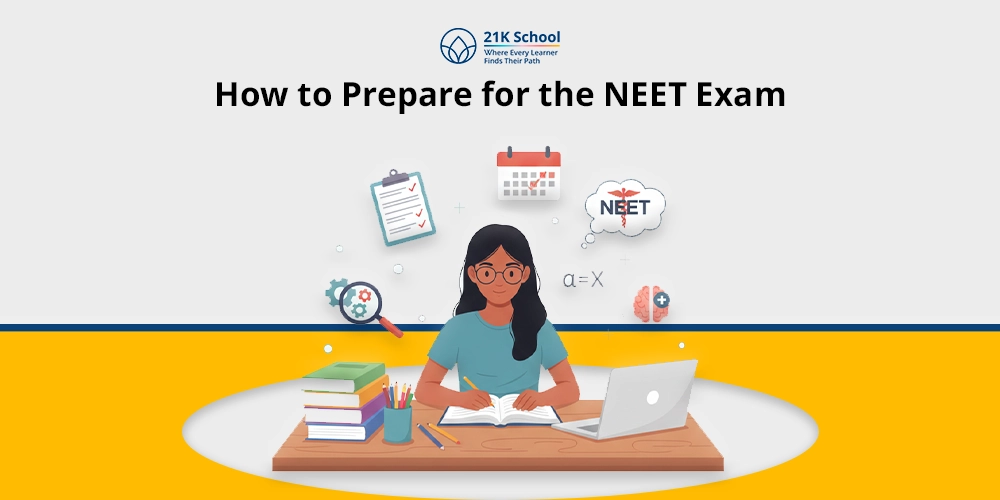
Learners in the Industrial Training Institute (ITI) tend to learn practical vocation. But they might not have formal academic certificates needed to advance in education or even in some job opportunities.
In order to fill this gap, the National Institute of Open Schooling (NIOS) , the open schooling arm under the Ministry of Education, India partnered with the Directorate General of Training (DGT) to provide credentialing routes.
Under this scheme, ITI students get formal Secondary (Class 10) or Senior Secondary (Class 12) certification. This happens through Transfer of Credit (TOC) , counting up to three ITI subjects and only needing two NIOS subjects.
This integrative model encourages academic parity, flexible, cost-effectiveness, and improved employability by vocational learners. This article digs into the opportunities NIOS courses offer ITI learners, admission criteria, steps involved, benefits, and challenges.
Contents
How NIOS facilitates ITI learners
NIOS provides ITI learners with educational certificates of secondary (Class 10) and senior secondary (Class 12) alongside their vocational education . This assists these learners into getting greater chances of employability and academic success.
Let’s delve into other reasons to choose NIOS by students including ITI learners:
1. Academic Equivalence
ITI students can be credited up to two or three ITI subjects. Further using the TOC facility under NIOS-ITI Memorandum of Understanding (MoU), based upon trade-specific mapping.
This entails that trainees only have to complete two more subjects (usually a language and an academic subject). This is to get a complete secondary or senior secondary certificate.
2. Recognition and validity
NIOS Secondary and Senior Secondary certificates find acceptance at national and international level. Few states such as Tamil Nadu include direct acceptance of such certificates equivalent to government service eligibility based on government job notifications.
Therefore it means that NIOS certificates are valid for government jobs . NIOS credentials are also accepted at equal terms as other boards by the Association of Indian Universities.
3. Secondary and Senior Secondary Certification
Learners can qualify with TOC and subject-specific criteria either a Class 12 certificate or a Class 10 certificate. This can be earned by ITI learners which provide academic parity and provide access to higher education or jobs.
For people having doubts, here is how to get admission in NIOS for 12th class .
4. Credit Transfer
TOC enables ITI learners to avoid repetitions studying the topics which they proved to know without difficulties. To qualify:
- Credit may be given on up to two or three subjects passed in previous five years by a recognized national or state board or equivalent ITI course.
- Such transfer may be allowed where there is NIOS curriculum that includes such subjects.
- When the diploma consists of theory+ practical, both requirements have to be met at the previous qualification.
This is in the form of time saved, cost saving and a lighter study load on learners.
5. Flexible Subject Choices
Students make a choice after getting TOC credits on ITI:
- One language subject: E.g. English, Hindi or other regional languages.
- One school/vocational course: e.g Maths, Science, Entrepreneurship, Employability Skills, Computer Applications.
This is flexible to take care of academic interest and future aspirations.
Explore how many subjects are compulsory in NIOS class 12th .
6. Enhanced Employability
The NIOS certification with vocational certifications puts so much sense in placing ITI graduates in the employable world. Industry, technical trade, and government employers are increasingly seeking applicants with an inter-mix of both skill-based education and academic credentials.
7. Variety of Topics
NIOS provides a wide choice: core subjects, language courses, vocational training courses related to trade and soft skill modules. This enables one to tailor as per career avenues.
8. Access to College
Being a student of ITI, with a Class 10 or 12 certificate, the learners become eligible to graduation programmes (B.A., B.Sc., B.Com).
Even polytechnic diplomas and professional courses are being accepted by universities in India and abroad. They regularly admit the NIOS students without their having to get any further equivalency certificates.
9. Affordable Education
There is a socio-economic access priority. NIOS has e-services with modest fees like 150 per TOC subject and minimal registration/examination.
And the fee is very less compared to full board enrollment.
How ITI Learners Can Enroll in NIOS?
Getting admission in NIOS is quite simple. Students also might wonder how to apply for NIOS admission online . Well here are the guided steps.
Step 1: Visit the NIOS Portal:
The process of enrollment starts at the official NIOS site. The online admission portal is utilized by the learners to access the TOC application services by registering.
Step 2: Select Secondary or Senior Secondary
Eligibility:
- Secondary (Class 10): 14-year age and ITI enrolment after Class 8
- Class 12 and above: 15 and above years with ITI admission or completion after Class 10
Step 3: Upload Documents (Age & ITI Proof)
Post digitally scanned papers:
- Age certificate(birth certificate, school record)
- ITI enrollment or pass certificate (NCVT/SCVT) showing trade and passed subjects
Step 4: Pay Registration and TOC Fee
There is a low fee to be charged during the registration; TOC is 150/- per subject (500/- when done after registration).
Step 5: Subjects Selection
Three subjects of the ITI course are credited. The learner chooses two in NIOS: one language, one academic/ vocational.
Eligibility Criteria
- Should have completed ITI subjects of a recognized board in the last five years.
- Scored a pass mark of 33% or more in every subject.
- TOC just for such ITI topics that suit NIOS subject mapping and cover both parts of practical subjects.
Read on to learn more about NIOS eligibility criteria for class 12 .
Admission Process
- Registration via stream selection (Secondary /Sr Secondary)
- Submit genuine records
- Submit TOC application
- Choose other two NIOS subjects
- Pay online
- Select examination mode: Public Exam(April/November) or On-Demand Examination System
Popular Subjects for ITI Learners in NIOS
The common choices of subjects:
- Hindi, English, Sanskrit
- Core academic: Mathematics, Science, Social Science
- Vocational: Employability Skills and Entrepreneurship, Digital Literacy
- Secretarial or Computer Practice (in case it is included in their curriculum)
Examination System
- NIOS conduct Public Examinations in April-May and October-December annually
- On-Demand Examinations (ODEs) give the facility of subjectwise flexible timetabling of exams containing no public exams
- This makes use of the ITI students who have to deal with working schedules.
Advantages of integrating ITI and NIOS Certification
We all know the NIOS board benefits . And if they are integrated with ITI and its vocational training, it can do wonders for learners’ employability and credits.
1. Better Job Opportunities
Due to the integration of ITI and NIOS students have dual slate in both vocational and academic endorsement. It gets learners in readiness to work as supervisors, semi-skilled positions, and areas with low requirements of education.
2. Higher Education Pathways
Under Class 10/12 equivalent certificates, learners qualify for undergraduate degrees, poly-technics, and also technical diplomas.
3. Skill + Academic Certification
This two-fold benefit fits with national skills missions and employer requirements: recognition of practical ability and theoretical knowledge.
Understand Practical knowledge vs Theoretical knowledge .
4. Eligibility to Government Job
There are a number of educational requirements in the recruitment standards imposed publicly. NIOS covers the minimal standards in the same way, which are acknowledged by various state notifications.
Challenges and Solutions to ITI Learners in NIOS
Due to having so much on plate, ITI learners might face certain difficulties when enrolled with NIOS as well. However, these challenges can be cut down with considerable planning and assistance.
1. Time Management and Self Discipline
Such programs in ITIs are more intense and practical with a pre-decided workshop timetable, assignments, and practical tests. Over this, throwing additional academic subjects is an overload to learners, particularly those who are combining part-time employment or family duties.
Solution: Develop weekly plans, follow TMA submission instructions, check the NIOS online learning materials, and monitor schedules. Through this they learn time-management skills and maintain student discipline .
2. Poor Classroom Interaction
NIOS is also a distance learning system implying a lack of daily contact with a teacher. Most of the learners in ITI are accustomed to practical instructions and struggle to remain motivated during self-regulated learning .
Solution: Form local study groups, utilise the power of online forums/WhatsApp groups or take part-contact classes at the recognised NIOS study centres.
3. Exam Preparation
ITI programmes are largely practical with the main specialisation either in tools, machines or workshops. A transition to academic subjects becomes heavy on theory exams. And therefore, subjects such as History, Economics, or Science may be mentally taxing.
Solution: Take sample papers, official past exam-booklets and On-Demand Exams in order to choose the most convenient timings.
Conclusion
By combining ITI vocational education with a formal academic certification using the Transfer of Credit system of NIOS, learners can gain two diplomas that combine practicality with academic accolade.
The model is disruptive. It takes employment opportunities to a new level, opens access to higher education and confirms government job opportunities. And that too with a low cost, and with no fixed timing of study.
Also some obstacles to time and self-management remain intact. NIOS offers students tools, such as On-Demand exams, electronic submission, and community of peers. NIOS is a viable, learner-centered pathway to better futures during which ITI students can secure academic parity and more opportunity.


